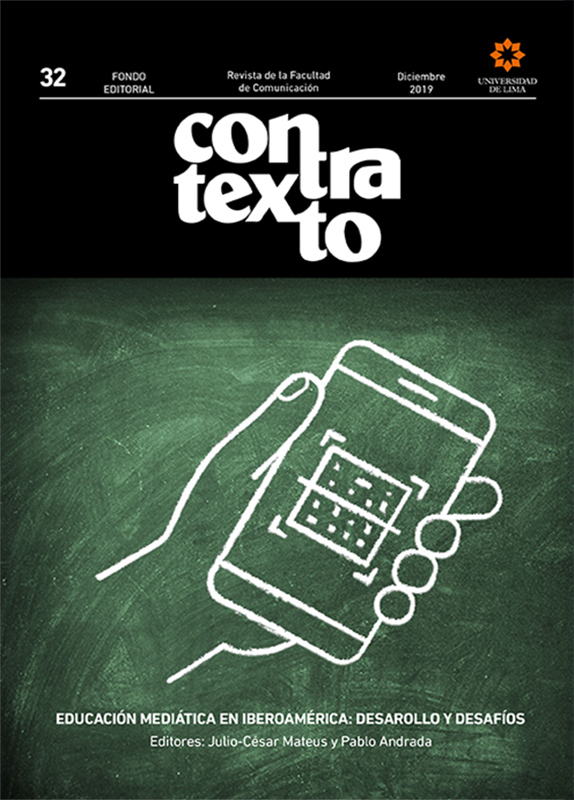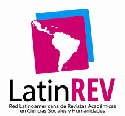Programming and robotics: how and what for. Analysis of education policies in Argentina
DOI:
https://doi.org/10.26439/contratexto2019.n032.4607Keywords:
Programming, Robotics, Media Education, Digital Literacy, Education PolicyAbstract
Although the relationship between programming, robotics and education has a long history, these specific knowledge and skills were not explicitly included in the official documents of the Latin American education policy until recently. Argentina is the first South American country in which programming and robotics are included in the basic contents of compulsory education. In this article, based on a qualitative analysis of a set of official documents, we propose to explore the arguments favoring the inclusion of programming and robotics in formal education, and the way in which they are suggested to be incorporated in classrooms.
Downloads
References
Adell, J. S., Llopis, M. A. N., Esteve, M. F. M. y Valdeolivas, N. M. G. (2019). El debate sobre el pensamiento computacional en educación. RIED. Revista Iberoamericana de Educación a Distancia, 22(1), pp. 171-186. doi: http://dx.doi.org/10.5944/ ried.22.1.22303
Albarello, F. (2014). Acceso y uso de las pantallas en la escuela media: hacia una reformulación del acto de lectura. En M. Pini, S. Más Rocha, J. Gorostiaga, C. Tello y G. Asprella, La educación secundaria ¿Modelo en (re)construcción? (pp. 223-244). Buenos Aires, Argentina: Aique.
Alimisis, D. (2013). Educational robotics: Open questions and new challenges. Themes in Science and Technology Education, 6(1), 63-71.
Alsina, A. y Acosta Inchaustegui, Y. (2018). Iniciación al álgebra en educación infantil a través del pensamiento computacional: una experiencia sobre patrones con robots educativos programables. Unión: Revista Iberoamericana de Educación Matemática, 52, 218-235.
Atmatzidou, S. y Demetriadis, S. (2016). Advancing students’ computational thinking skills through educational robotics: A study on age and gender relevant differences. Robotics and Autonomous Systems, 75, 661-670.
Benitti, F. B. V. (2012). Exploring the educational potential of robotics in schools: A systematic review. Computers & Education, 58(3), 978-988.
Bocconi, S., Chioccariello, A., Dettori, G., Ferrari, A., Engelhardt, K., Kampylis, P. y Punie, Y. (2016). Developing computational thinking in compulsory education. European Commission, JRC Science for Policy Report.
Buckingham, D. (2008). Más allá de la tecnología. Aprendizaje infantil en la era digital. Buenos Aires, Argentina: Manantial.
Buckingham, D. (2003). Educación en medios. Alfabetización, aprendizaje y cultura contemporánea. Barcelona, España: Paidós.
Chin, K.-Y., Hong, Z.-W. y Chen, Y.-L. (2014). Impact of Using an Educational Robot- Based Learning System on Students’ Motivation in Elementary Education. IEEE Transactions on Learning Technologies, 7(4), 333–345. https://doi.org/10.1109/ TLT.2014.2346756
Comisión Europea (2018). Comunicación de la Comisión al Parlamento Europeo, al Consejo, al Comité Económico y Social Europeo y al Comité de las Regiones sobre el Plan de Acción de Educación Digital. Recuperado de https://eur-lex. europa.eu/legal-content/ES/TXT/PDF/?uri=CELEX:52018DC0022&from=EN 91
Comisión Europea. JRC Technical Reports. (2012). Digital Competence in Practice: An Analysis of Frameworks. Recuperado de http://jiscdesignstudio.pbworks. com/w/file/fetch/55823162/FinalCSReport_PDFPARAWEB.pdf
Comisión Europea (2019a). Europe 2020 Strategy. Recuperado de http://ec.europa.eu/ digital-agenda/en/our-goals
Comisión Europea (2019b). Digital Skills Initiatives. Recuperado de https://ec.europa.eu/ digital-single-market/en/digital-skills-initiatives
Decreto 386-18, Plan Aprender Conectados. Boletín Oficial de la República Argentina. Buenos Aires, Argentina, 2 de mayo del 2018.
Decreto 459-10, Créase el Programa Conectar Igualdad. Com. Ar de incorporación de la nueva tecnología para el aprendizaje de alumnos y docentes. Boletín Oficial de la República Argentina. Buenos Aires, Argentina, 7 de abril del 2010.
Dirección General de Escuelas de la Provincia de Mendoza. NAP de Educación Digital, Programación y Robótica. Mendoza, Argentina. Recuperado de http://www. mendoza.edu.ar/nap-de-educacion-digital-programacion-y-robotica/
Empirica (2013). E-Leadership: E-skills for Competitiveness and Innovation, Vision, Roadmap and Foresight Scenarios. Final Report. Recuperado de http://eskills-vision.eu/fileadmin/eSkillsVision/documents/VISION%20Final%20Report.pdf
Ferrés, J. (2014), Las pantallas y el cerebro emocional, Barcelona, España: Gedisa
Ferrés, J. (2008) La educación como industria del deseo. Un nuevo estilo comunicativo. Barcelona, España: Gedisa.
García-Valcárcel, A. y Caballero-González, Y. A. (2019). Robotics to develop computational thinking in early Childhood Education. Comunicar, 27(59), 63-72.
Gaudiello, I. y Zibetti, E. (2016). Learning Robotics, with Robotics, by Roboticss: Educational Robotics (Vol. 3). Hoboken, NJ, USA: John Wiley & Sons, Inc. https://doi. org/10.1002/9781119335740
Google (2015). Access and Barriers in U.S. K-12 Searching for Computer Science. Recuperado de http://services.google.com/fh/files/misc/searching-for-computer-science_ report.pdf
Informatics Europe y ACM Europe. (2013). Informatics Education: Europe cannot afford to miss the boat. Recuperado de http://europe.acm.org/iereport/ ACMandIEreport.pdf
Karim, M. E., Lemaignan, S. y Mondada, F. (2015). A review: Can robots reshape K-12 STEM education? 2015 Ieee International Workshop on Advanced Robotics and Its Social Impacts (Arso). Lyon (Francia).92
Landau, M. (2013). Cultura digital y cultura escolar en las prácticas de enseñanza de la comunicación. Una aproximación al estudio de los edublogs. En Sel, S., Armand, S. y Pérez Fernández, S. (Eds.) ¿Post-analógico? Entre mitos, pixeles y emulsiones. (pp. 101-122). Buenos Aires, Argentina: Prometeo.
Lankshear, C. y Knobel, M. (2008). Introduction. Digital literacies-Concepts, policies and practices. En C. Lankshear y M. Knobel (Eds.) Digital Literacies. Concepts, policies and practices. NY: Peter Lang.
Ley 26.206 Ley Nacional de Educación. Boletín Oficial de la República Argentina, Buenos Aires, Argentina, 28 de diciembre del 2006.
Manovich, L. (2013). Software takes command, Nueva York, Estados Unidos: Bloomsbury Academic.
Merino, J.M., Villena, R., González-Calero, J.A. y Cózar, R. (2018). Análisis del efecto de la robótica en la motivación de estudiantes de tercero de educación primaria durante la resolución de tareas de interpretación de planos. REXE: Revista de Estudios y Experiencias en Educación, 2(3), 163-173.
Morozov, E. (2013). To save everything click here. The Folly of Technological Solutionism. Nueva York, Estados Unidos: Public Affairs.
Orsini, L. (2014). How Learning To Code Reached Critical Mass In 2014. Readwrite. Recuperado de http://readwrite.com/2014/12/30/learning-to-code-2014-tech-education/
Papert, S. (1980). Mindstorms. Nueva York, Estados Unidos: Basic Books.
Resnick, M. (2001). Tortugas, termitas y atascos de tráfico. Barcelona, España: Gedisa.
Resnick, M. y Siegel, D. (2015). A Different Approach to Coding. Bright/Medium. Recuperado de https://medium.com/bright/a-different-approach-to-coding-d679b06d83a#. 6r4skthht
Resolución del Consejo Federal de Educación 343-18 Aprobación e implementación de núcleos de aprendizajes prioritarios para educación digital, programación y robótica (NAP). Buenos Aires, Argentina, 12 de septiembre del 2018.
Resolución del Consejo Federal de Educación 263-15. Buenos Aires, Argentina, 12 de agosto del 2015.
Sánchez Tendero, E., Cózar Gutiérrez, R y González-Calero Somoza, J. (2019). Robótica en la enseñanza de conocimiento e interacción con el entorno. Una investigación formativa en educación infantil. Revista Interuniversitaria de Formación del Profesorado, 94 (33.1), 11-28.93
Smith, M. (30 de enero del 2016). Computer Science for All. The White House Blog. Recuperado de https://www.whitehouse.gov/blog/2016/01/30/computer-science-all
Strauss, A. y Corbin, J. (1994). Grounded theory methodology. Handbook of qualitative research, 17, 273-85.
Unesco (2013). Media and information literacy: policy and strategy guidelines. Recuperado de https://unesdoc.unesco.org/ark:/48223/pf0000225606
Urien, P. (25 de octubre del 2015). El desafío de entrenar a los jóvenes para los trabajos que sí los necesitan. La Nación. Recuperado de http://www.lanacion.com. ar/1839349-el-desafio-de-entrenar-a-los-jovenes-para-los-trabajos-que-si-los-necesitan
Wing, J. M. (2006). Computational thinking. Communications of the ACM, 49(3), 33-35.
Winner, L. (1980). Do artifacts have politics? Daedalus, 121-136.
Downloads
Published
Issue
Section
License
All of the works published are licensed under a CC BY 4.0 Creative Commons Attribution license. (updated on March 1st 2021)
The content of the journal may be shared in any material or format. The content may be adapted, contributed upon and transformed. Both possibilities are only permitted in so far as they complete the following conditions:
- Attribution: Credit must be given where it is due, a link to the license must be provided and changes, if made, must be indicated. This should be done in the manner deemed appropriate, without suggesting that the licensor promotes you or your use of the material.
Ownership rights
The patrimonial rights for Contratexto are published under a Creative Commons BY 4.0 license, allowing authors to keep the patrimonial rights to their work without restrictions.
If a work published in Contratexto were to be copied, distributed, spread, or any other activities contemplated in the aforementioned license, the author(s) and the journal must be mentioned visibly and expressly.
Self-archive
This journal allows and encourages authors to post items submitted to the journal on personal websites or institutional repositories both prior to and after publication, while providing bibliographic details that credit, if applicable, its publication in this journal.

















